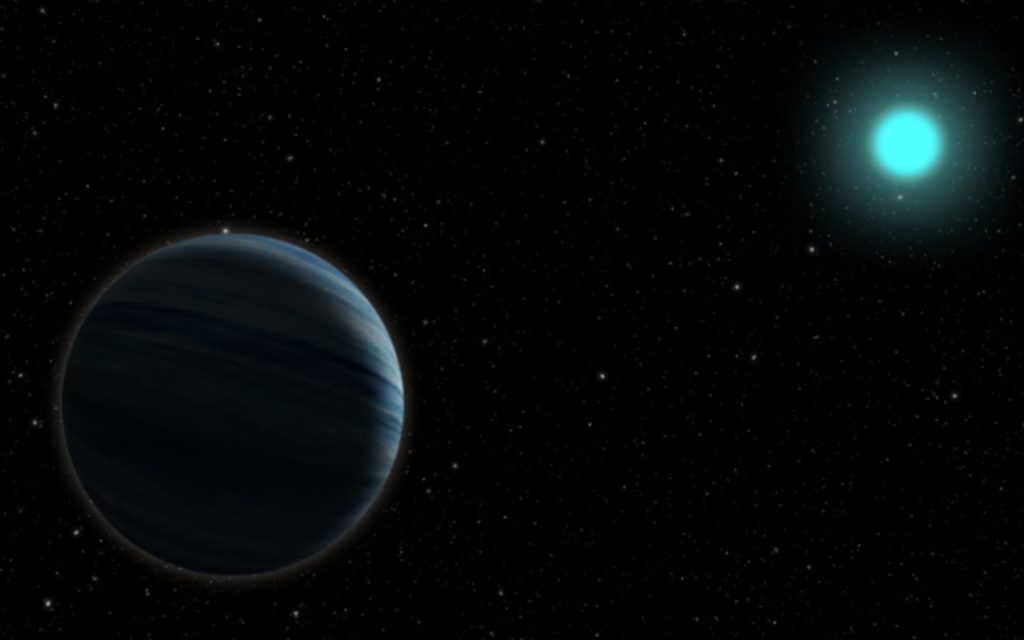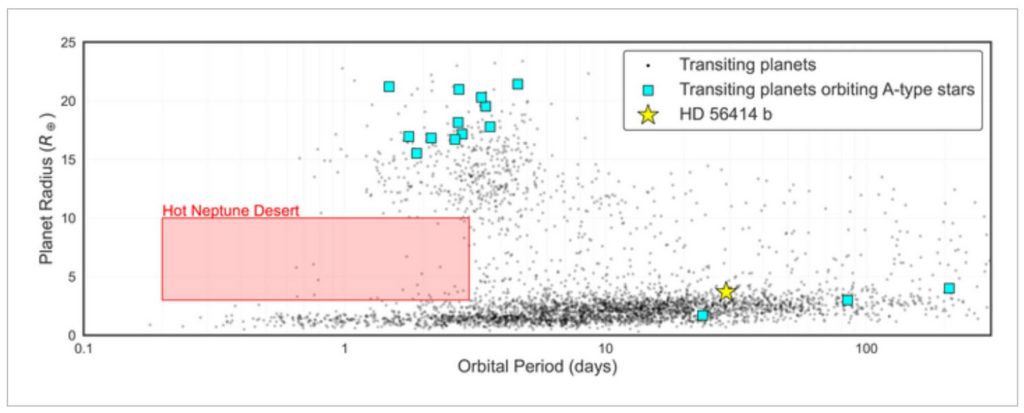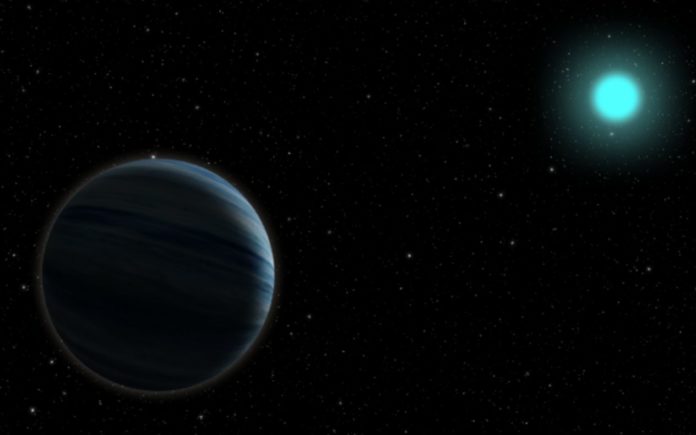A rare discovery — a ‘warm Neptune’ orbiting a brilliant blue star —can help explain why there aren’t many “hot Neptunes.”
In our galaxy, thousands of exoplanets have been discovered during the past 25 years, but more than 99% of them circle smaller stars, ranging from red dwarfs to stars that are only slightly more massive than our sun, which is regarded as an average-sized star.
Few have been detected around even more massive stars, such as A-type stars, which are brilliant blue stars twice the size of the sun, and the majority of those discovered are the size of Jupiter or greater. A-type stars include the sun-like Sirius and the greenish-blue Vega, two of the brightest stars in the sky.
UC Berkeley astronomers have discovered a new Neptune-sized planet, HD 56414 b, orbiting one of this hot-burning, but short-lived, A-type stars. They also provide a hint as to why so few gas giants smaller than Jupiter have been observed around the brightest 1% of stars in our galaxy.
This newly discovered planet has a longer orbital period than most previously known exoplanets, which makes it more difficult for current exoplanet detection techniques to locate planets with short, quick orbital periods around their stars. Researchers think that a planet the size of Neptune that is closer to a bright A-type star would be quickly stripped of its gas by the harsh radiation from the star, leaving only a core that can’t be seen.

This theory has been put forward to explain so-called “hot Neptune deserts” around redder stars. However, it was not known if it also applied to hotter stars, like A-type stars, which are 1.5 to 2 times hotter than the sun, because there aren’t many planets known to orbit them.
“It’s one of the smallest planets that we know of around these really massive stars,” remarks UC Berkeley graduate student Steven Giacalone. “In fact, this is the hottest star we know of with a planet smaller than Jupiter. This planet’s interesting first and foremost because these types of planets are really hard to find, and we’re probably not going to find many like them in the foreseeable future.”
Scorching Neptune desert
The discovery of a “warm Neptune,” as the researchers refer to it, just outside the region where the planet would have lost its gas suggests that bright, A-type stars may have a large number of unseen cores within the hot Neptune zone that are waiting to be discovered through more sensitive techniques.
“We might expect to see a pileup of remnant Neptunian cores at short orbital periods” around such stars, the team writes in their paper.
The discovery advances our knowledge of how planetary atmospheres change, according to Courtney Dressing, an assistant professor of astronomy at UC Berkeley.

“There’s a big question about just how do planets retain their atmospheres over time,” Dressing adds.
“When we’re looking at smaller planets, are we looking at the atmosphere that it was formed with when it originally formed from an accretion disk? Are we looking at an atmosphere that was outgassed from the planet over time? If we’re able to look at planets receiving different amounts of light from their star, especially different wavelengths of light, which is what the A stars allow us to do — it allows us to change the ratio of X-ray to ultraviolet light — then we can try to see how exactly a planet keeps its atmosphere over time.”
Giacalone and Dressing detailed their discovery in a report that was published online and accepted by The Astrophysical Journal Letters.
Dressing claims that it is generally known that highly irradiated, Neptune-sized planets around sun-like stars are less common than anticipated. However, since planets circling A-type stars are difficult to find, it is unknown if this holds true for those planets.
And compared to smaller F, G, K, and M dwarfs, an A-type star is a different species. Sun-like stars expose close planets to significant levels of X-ray and ultraviolet radiation, whereas A-type stars expose them to substantially more near-ultraviolet radiation than either X-ray or severe ultraviolet radiation.
“Determining whether the hot Neptune desert also extends to A-type stars provides insight into the importance of near-ultraviolet radiation in governing atmospheric escape,” she explains. “This result is important for understanding the physics of atmospheric mass loss and investigating the formation and evolution of small planets.”
NASA’s TESS mission found the planet HD 56414 b as it passed in front of its star, HD 56414. By acquiring spectra with the 1.5-meter telescope run by the Small and Moderate Aperture Research Telescope System (SMARTS) Consortium at Cerro Tololo in Chile, Dressing, Giacalone, and their colleagues were able to determine that HD 56414 was an A-type star.
The planet orbits the star every 29 days at a distance that is roughly one-fourth the distance between Earth and the sun. Its radius is 3.7 times that of Earth. The system is far more recent—420 million years—than the 4.5 billion years of our sun.
The researchers simulated the effect of the star’s radiation on the planet and determined that, while the star may be slowly eroding its atmosphere, it would likely live for a billion years — well beyond the time when the star is projected to burn up and collapse, resulting in a supernova.
Jupiter-sized planets, according to Giacalone, are less vulnerable to photoevaporation because their cores are big enough to retain their hydrogen gas.
“There’s this balance between the central mass of the planet and how puffy the atmosphere is,” he explains. “For planets the size of Jupiter or larger, the planet is massive enough to gravitationally hold on to its puffy atmosphere. As you move down to planets the size of Neptune, the atmosphere is still puffy, but the planet is not as massive, so they can lose their atmospheres more easily.”
Giacalone and Dressing are still looking for Neptune-sized exoplanets around A-type stars, hoping to find more in or near the hot Neptune desert to learn more about where these planets form in the accretion disk during star formation, whether they move inward or outward over time, and how their atmospheres evolve.
Image Credit: Getty
You were reading: Rare Find — A ‘warm Neptune’ Seems Can Strip Neptune-sized Planets To Their Rocky Cores
